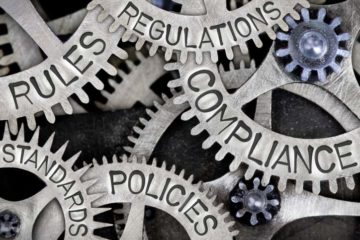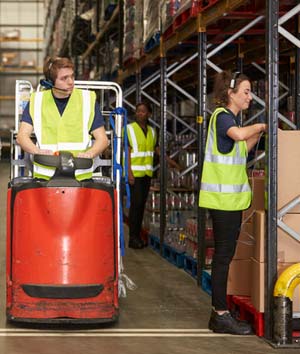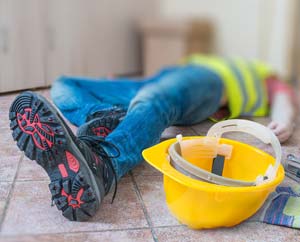Client case studies
Learn how our consultants help clients tackle real world health and safety issues...
Learn how our consultants help clients tackle real world health and safety issues...
 We’ve brought all the fundamentals together in one handy place
We’ve brought all the fundamentals together in one handy placeYou can’t afford to ignore health and safety legislation: it applies to all businesses, including self–employed sole traders. But if you find the idea of controlling risk daunting, you needn’t. We’ve got your back, with this authoritative and easy to follow health and safety guidance for employers.
This article highlights what you should be doing, how and when, to manage risks at your organisation, avoid prosecution, protect your corporate reputation and keep your people well.

You may need support and advice from a competent external source to tell you what you need to do, or to carry out work for you. An external specialist may also be able to spot hazards you are unaware of, such as those around manual handling, or working with high risk work equipment.
If you use external help, do your homework and decide what it is you need help with. For example, carrying out fire risk assessments, ergonomic workstation assessments or noise assessments can require levels of expertise and knowledge that not everybody has.
Make sure any external sources you use are reputable and themselves competent; check their qualifications and experience for the work you want them to carry out.

At System Concepts we deliver wide ranging health and safety guidance for employers, with consultancy services including: remote telephone and email support; providing onsite consultants to manage your risks; carrying out general risk assessment; fire risk assessment and consultancy; ergonomic and human factors consultancy; access audits and disability management services; delivering IOSH certified training; auditing against legal requirements, your internal policies or against ISO or British Standards; and noise surveys and management.

Contact our consultants for an informal chat about your requirements
Employers should have a health and safety policy stating the arrangements for managing health and safety e.g. who does what, when, and how. It is proof to your employees and others of the organisation’s commitment to managing health and safety at work.
If you’re unsure what your policy should contain, the Health and Safety Executive (HSE) provides standard health and safety guidance for employers, and templates for anyone to access. However for policies to be meaningful and effective, they need to reflect your specific business aims, objectives and culture. Organisations and the risks they face are ever changing, so it’s important your health and safety policies are reviewed and revised to keep pace with change.
Note that if your organisation employs less than five people, you do not need to document a health and safety policy. Nevertheless, having something in writing is helpful, for example, to communicate to your employees.
You are required to tell your staff about health and safety law. This includes what you as an employer are required to do, as well as what staff are required to do. You can give this information to staff via a traditional heath and safety law poster, or make it accessible via a leaflet, both of which are available from the HSE.
Most organisations face health and safety hazards, but to varying degrees. Carrying out a structured risk assessment is a useful way to ensure you carefully think about actual and potential hazards, who may be harmed by them, how harm may occur, and whether you are doing all that is reasonable to prevent harm. Don’t forget you should be considering hazards that are not always present or visible to you, such as using chemicals, poor lighting, noise or work related stress.
If you are going to complete your own risk assessments, you should carry out research on the various hazards. Some sets of legislation require risk to be assessed in specific ways; for instance, how you assess manual handling risks is different to assessing risks from chemicals, and even more different from assessing risks from fire.
Tools you can use include government websites that publish guidance topics such as fire safety and legislation, trade associations and unions specific to your industry, for example Unison publishes guidance for members, and professional bodies such as the Chartered Institute of Personnel and Development (CIPD).
After you have completed a risk assessment, you may have a list of things you need to do. This could range from arranging further more detailed risk assessments on topics such as water hygiene (legionella) or fire, through to developing procedures for people to follow, employee training, or thinking about how you can test your control measures to ensure they are effective (audits or practice exercises such as fire drills, etc.).
If your organisation employs less than five people, you do not need to document your risk assessments, but having something in writing is helpful to prove you have fulfilled this requirement should something go wrong, or if you are visited by an external regulator such as a fire officer or an environmental health officer for example. Documented risk assessments can also be used to tell employees and others what’s in place to protect them, and can be used to form the basis of staff training.
Our health and safety consultants have extensive experience in carrying out risk assessments for a wide range of clients, industries and topics. Take a look at the services we offer including fire safety and risk assessment consulting, display screen equipment services, ergonomics and human factors consulting. Our insights articles and client case study pages further showcase our knowledge and how we help our clients.
 5. Employee consultation
5. Employee consultationSafe and healthy workplaces and good safety culture are achieved when employees are engaged and given opportunities to participate. Consulting with your employees is not about telling staff things, it should be based on seeking and taking into account their views on health and safety matters, helping you to make informed decisions on workplace improvements and changes.
There are many ways in which you can consult your employees. These can range from straightforward planned meetings and discussions, through to workplace walkabouts, employee surveys and suggestion schemes: choose the methods that work for you and your staff.
No matter how big or small your organisation, people need to know what measures are in place to keep them safe, the standards to which they should work, and how to perform tasks safely.
When planning for health and safety information and training, think about the following:
Make sure your organisation’s health and safety training is relevant, timely, engaging and enjoyable. It’s a sound investment, when compared to the potential costs of workplace accidents, incidents, work related ill health or even fines.
At System Concepts we provide training on a wide range of topics for all types of organisations. Our consultants hold training qualifications and are also IOSH approved trainers, meaning we can deliver courses including IOSH Managing Safely® and IOSH Working Safely.
Our training services also cover manual handling and industrial ergonomics training, workstation assessor training, COSHH awareness and fire safety training. We have consultants who can develop and deliver bespoke training courses to meet your needs, and even write courses for IOSH approval.
We are able to spend time with you and your staff to understand what training is required and the best way to deliver it, so your people get the most from it.
Our consultancy team can even tailor a workplace ergonomics app to your organisation, providing a means of workstation training and assessment.

If you find working out what you need to do confusing, our consultants are experts at providing health and safety guidance for employers. This may involve working out occupancy levels, calculating how many toilets you need, advising on lighting issues or assessing your workplace against accessibility standards.
To get you started, here are some of the key things you need to consider:
Workplaces should be provided with sanitary facilities suitable for the people that use them. Depending on the nature of your work, you may need to provide somewhere for people to change, and storage for clothing. Drinking water and rest areas should also be provided.

Drawing up a schedule of what needs to be done and when is a good idea, to ensure you do not lose sight of requirements.
Carrying out periodic monitoring of what you put in place for your premises, plant, equipment and facilities is a great way to check how effective measures are, and spot any potential issues and failures before they become realised. Audits and inspections are great ways to monitor your workplace and gain assurance your management controls are effective. You can even consider topic specific audits, which focus on one area such as legionella or fire only.
When you arrange for aspects of your workplace to be maintained, e.g. your fire alarm and lifts, appointing the right, competent people is important. You should have processes in place to ensure contractors are suitably selected and controlled. We help our clients with independent contractor selection and management processes. These range from reviewing contractor competence levels for services they offer and carrying out selection interviews, through to periodic audits and inspections of their work.
Creating a healthy working environment includes considering the conditions in which people work. Generally, this means making sure the workplace temperature is reasonable for the type of work carried out, providing ventilation and suitable lighting. Other environmental considerations include work areas, workstations and seating; they should be well laid out, designed with ergonomics in mind, and allow people freedom of access and egress and room to move about.
Cleanliness is also important to think about: you may simply need to ensure waste does not build up, or you may have hazardous waste such as chemicals or oily rags that may be a fire hazard. If your workplace has transport onsite, you need to consider how suitable segregation from pedestrians is achieved.
It’s important you have appropriate first aid arrangements in your workplace. First aid is the immediate medical assistance given to someone suffering from an accident, injury or illness, to help prevent conditions worsening before professional medical help arrives. It can save lives and prevent minor injuries becoming major ones.

System Concepts consultants have carried out many site specific first aid needs assessments, for a wide range of organisations. These assessments identify whether first aid provision is suitable, or what more could be done to ensure staff safety.
Things don’t always go to plan. Accidents, near misses and ill health can occur, even in low risk organisations and for a variety of reasons, sometimes which aren’t immediately obvious.
Your organisation should have processes to:
Also, bear in mind that the Reporting of Injuries, Diseases, Dangerous Occurrences Regulations (RIDDOR) require certain injuries, incidents and work-related diseases to be reported to the Health and Safety Executive (HSE) so you’ll need processes in place to ensure things are reported within the required timescales, using the correct methods.
Our health and safety consultants can support you by creating your internal accident reporting procedures and templates, developing bespoke training on accident investigation and reporting, or even helping to review incidents and determine whether they are covered by RIDDOR.
Good health and safety is about taking reasonable measures to control and reduce the risk of things going wrong, someone getting hurt, or becoming ill due to work. However, if employer negligence is identified for an employee’s work related injury or ill health, employer’s liability insurance will help. You should always seek insurance cover from an authorised provider.
Maintaining your knowledge on changes to legislation or industry best practice will help you plan for what is to come, so your organisation remains compliant. Doing this needn’t be costly, there are many ways to stay up to date using free sources of health and safety guidance for employers, for example:

Contact our consultants for an informal chat about your requirements
Learn how our consultants help clients tackle real world health and safety issues...
Learn how our consultants help clients tackle real world health and safety issues...
Access our extensive archive of health and safety articles, including detailed commentary and actionable advice...
Access our extensive archive of health and safety articles, including detailed commentary and actionable advice...
Manage risk, protect the people in your organisation and enhance your business...
Manage risk, protect the people in your organisation and enhance your business...